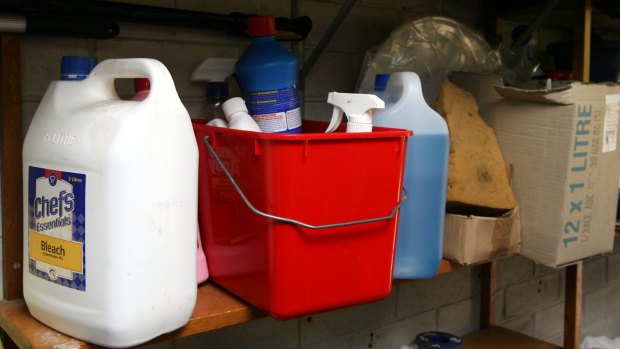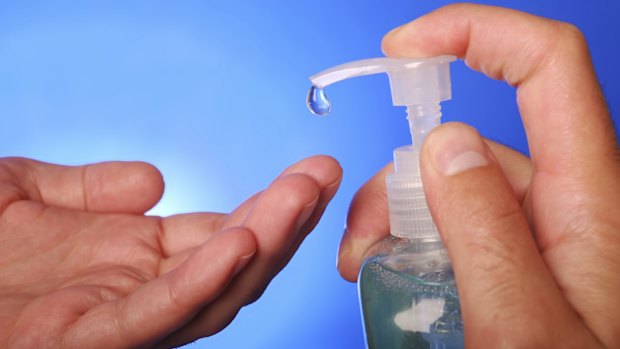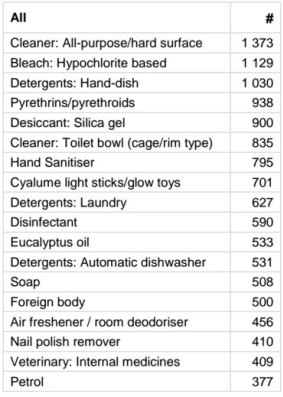- Business
- Consumer affairs
This was published 8 years ago
Almost 2500 Australian children admitted to hospital every year from poisoning, report reveals
By Lucy Cormack
Almost 2500 children are admitted to hospital every year due to poisonings, a new report released by the Australian Competition and Consumer Commission has found.
The report, which revealed two-year-old children have the highest incidence of accidental poisoning, analysed calls made to the Poisons Information Centres from June 2014 to May 2015.

All-purpose and hard-surface cleaners, detergents, bleach and toilet bowl products are among the most common causes of poisoning among children.Credit: Peter Morris
All-purpose and hard-surface cleaners, detergents, bleach, toilet bowl products and glow sticks were among the most common causes of poisoning among children.
"Each year, 180,000 calls are made to Poisons Information Centres in Australia, with about half of these relating to children," ACCC deputy chair Delia Rickard said.

Babies aged 0 to 4 weeks are often exposed to substances while in use by a parent or carer.Credit: iStock
"The most serious incidents relate to carbon monoxide exposure, button batteries, caustic cleaners such as oven and BBQ cleaners, acids, pool chemicals, household bleaches and herbicides."
While household cleaning products were significant contributors, medicines were found to be the most common source of poisons exposure overall for all ages.
The most common form of chemical exposure is through ingestion, the report revealed.
"This is followed by ocular and dermal exposures and exposure by inhalation. Calls relate to exposures that result in a wide range of symptoms including internal symptoms, skin reactions and burns."

Common household products with the highest poison frequency.Credit: ACCC, Poisons Information Centre
The report comes as a reminder of the many seemingly innocent but potentially harmful poisons lying around the home.
Disc or button batteries, alkalis and pool acid were found to be the top three products with the highest rates of callers (more than 100 calls total) in hospital or referred to hospital, while pool chlorine, oven or grill cleaner and alkalis were the top three products with the highest rate of callers presenting symptoms related to exposure.
Ms Rickard warned parents to be vigilant over the Easter period when taking families on holiday.
"Poisonings often occur on holidays when families are heading to holiday houses or visiting friends and relatives who may not have young children," she said. "Check the house on arrival to ensure medicines and household chemicals cannot fall into little hands."
The majority of poison cases referred to hospitals by the NSW Poisons Information Centre find their way to emergency departments, but they are usually not admitted.
Data collected in the report by the NSW Poisons Information Centre represented about half of Australia's total poison-related calls because they field national calls after hours.
Which poisons at which age?
Neonates (0-4 weeks)
While frequency is very low, neonates can be exposed to substances in connection with a parent or carer, such as hand sanitiser, eucalyptus oil and pens/ink or through contact with detergents used to clean baby bottles.
Infants (4 weeks-1 year) and toddlers (1-4 years)
The highest risk age group, commonly associated with substances near ground level such as toilet bowl cleaners, all-purpose/hard-surface cleaner and detergents, or items such as hand sanitisers, desiccants, pens/ink and cigarettes/tobacco products. These are all products a toddler may ingest or put in their mouth.
Children (5-14 years)
While children in this age group are growing out of exploring objects by mouthing them, there are still risks. The most common chemicals they face are those in products such as glow sticks, all-purpose/hard-surface cleaner, freezer/cold packs and domestic insecticides.
Adolescents (15-19 years)
Potential self-harm and misuse of chemicals most commonly lead to chemical exposure in adolescents. Calls to the Poisons Information Centre often relate to bleach, deodorants/antiperspirants and petrol. Exposure to petrol is likely to be indicative of siphoning. High risk-taking behaviour is typically associated with this age category.
Adults (20-74 years)
Adults are most likely exposed to chemicals in the course of cleaning and maintenance of the home, but also in the workplace, with bleach, pesticides, all-purpose/hard-surface cleaner, hand dishwashing detergent and oven/grill cleaner among the main culprits.
Elderly (>75 years)
Frequency of exposure to chemicals for the elderly is highest for denture cleaning agent, eucalyptus oil, bleach and domestic insecticides. Some products may also be mistaken for a conventional medicine, such as cough syrup.